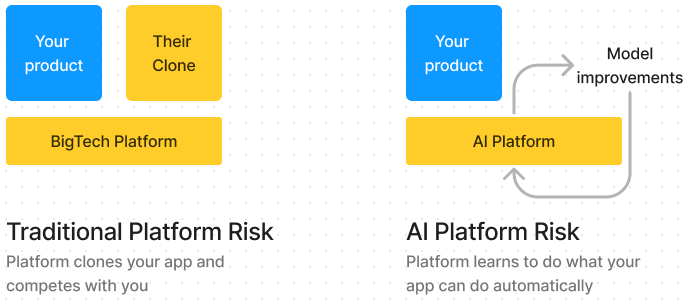If you build a product or startup on someone else’s platform, you’re always subject to some degree of platform risk. When you release an app on the iOS app store, there’s a risk that Apple could build a copycat themselves. Anyone who has ever marketed a direct to consumer product through Amazon knows that anything successful enough will get cloned by Amazon Basics. A famous historical example of platform risk is the browser wars in the 90s: Microsoft bundled Internet Explorer for free with every copy of Windows, killing demand for Netscape Navigator, and eventually leading to the antitrust case that almost broke apart Microsoft.
However, with AI, a completely new type of platform risk is emerging. If you’re building on top of APIs from OpenAI or Anthropic, the risk is that improvements to their AI models will naturally wipe out your product’s value add, completely by accident. As the models scale up, they spontaneously acquire new abilities and require less and less prompt engineering to produce useful results. This can feel totally random: even OpenAI and Anthropic themselves don’t know what types of capabilities will spontaneously emerge as they scale their models.

We’ve already seen this with the capabilities gains from GPT-3 to 3.5 to 4. LLM abilities that took lots of prompting and output massaging in GPT-3 are really easy to access in GPT-4. A company like Jasper.ai is an illustrative example. Jasper is an AI copywriting tool that helps people write website copy, blog posts, or ad copy. When Jasper first started, GPT-3 was the state of the art model. It was difficult to go into the OpenAI playground and ask it for copy suggestions. Getting high-quality prose from GPT-3 took significant work to avoid cheesy or generic copy. But with GPT-4, it’s a lot easier–many people can get interesting results from ChatGPT directly with minimal prompting skill. Jasper is still providing value for now, but it’s unclear whether that will still be true when GPT-5 comes out.
Difficulty Collapse
— Ate-a-Pi (@8teAPi) April 17, 2023
Problems in AI right now go from difficult to solved in a matter of months.
Challenging for startups. You identify an issue, work on patches to overcome it
Someone drops a new model
And it’s solved for everyone, meaning a ton of wasted effort https://t.co/kSYn2MLbC0
You can’t mitigate this risk by being multi-platform. The typical answer to platform risk is to diversify; Apple can’t hurt your business as much if you’re also on the Google Play store. But with LLMs, whether you’re using one model or many, the moment any of them demonstrate a notable improvement, it has the potential of siphoning away demand from your product.
The only way to avoid this risk is to provide durable value over and above prompt engineering. There are a few ways that startups can do this:
- Novel UI/UX: The difficulty that Jasper and other AI copywriting products have is that the entire mode of interaction is text-based, which is ideal for ChatGPT-style general purpose chat products to disintermediate. But if your product provides a novel mode of interaction, it’s unlikely the AI platforms will subsume you. Github Copilot is an IDE-based autocomplete which will only benefit from AI platform improvements, rather than be threatened by them.
- Domain-specific knowledge: AI models will scrape more and more of the internet but products can still have an edge by leveraging knowledge not easily found on the internet. For example, a B2B AI customer support bot might rely on prompt engineering built around a company’s own private knowledge base. No matter how good AI models become, they’ll still need additional context loaded in, and your product may be able to provide durable value there.
- Infrastructure value: Let’s say you’re building an analytics tool where part of the value is that users can specify SQL queries using natural language. At some point, AI models themselves will get good enough where ChatGPT itself can translate natural language to SQL without much prompting. However, if your analytics platform also handles things like optimizing query performance, this means there’s still durable value.
- Physical-world value: the current crop of AI models operate purely in the digital domain: text, images, video, audio. If your product connects their value to actions taken in the physical world, this is much more defensible.
There are lots of cool demos and interesting product launches coming out every day, but few of these will stand the test of time if they don’t find a way to provide value outside of prompt engineering.



